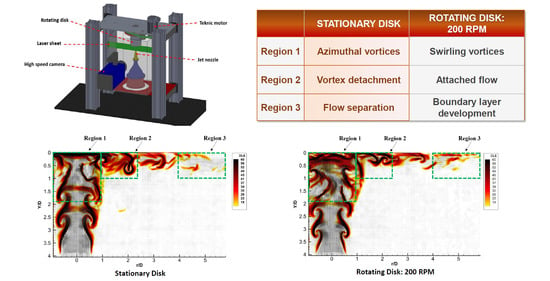Experimental Investigation of the Vortex Dynamics in Circular Jet Impinging on Rotating Disk
Abstract
:1. Introduction
2. Experimental Apparatus and Procedure
2.1. Jet Flow Facility
2.2. Time-Resolved Particle Image Velocimetry
2.3. Finite-Time Lyapunov Exponent (FTLE)
3. Results and Discussion
3.1. Radial Velocity Profiles
3.2. Flow Field Statistics
3.3. Instantaneous Velocity Fields and Vortex Dynamics; Eulerian Approach
3.4. Spatio-Temporal Description of the Vortex Dynamics; Lagrangian Approach
4. Conclusions
Author Contributions
Funding
Institutional Review Board Statement
Informed Consent Statement
Data Availability Statement
Conflicts of Interest
References
- El Hassan, M.; Assoum, H.H.; Martinuzzi, R.; Sobolik, V.; Sakout, A. Experimental investigation of the Wall Shear Stress in a circular orifice imping jet. Phys. Fluids 2013, 25, 077101. [Google Scholar] [CrossRef]
- Assoum, H.H.; El Hassan, M.; Abed-Meraim, K.; Sakout, A. The vortex dynamics and the self-sustained tones in a plane jet impinging on a slotted plate. Eur. J. Mech.-B/Fluids 2014, 48, 231–235. [Google Scholar] [CrossRef]
- El Hassan, M.; Assoum, H.H.; Sobolik, V.; Vetel, J.; Abed-Meraim, K.; Garon, A.; Sakout, A. Experimental investigation of the Wall shear stress and the vortex dynamics in a circular impinging jet. Exp. Fluids 2012, 52, 1475–1489. [Google Scholar] [CrossRef]
- Matsuda, S.; Katou, S.; Adaniya, H.; Tomioka, K. Heat transfer and flow characteristics from an impinging circular jet at low Reynolds numbers. Proc. Conf. Kyushu Branch 2017, 2017, 102. [Google Scholar] [CrossRef]
- Chen, Y.M.; Lee, W.T.; Wu, S.J. Heat (mass) transfer between an impinging jet and a rotating disk. Heat Mass Transf. 1998, 34, 195–201. [Google Scholar] [CrossRef]
- Benim, A.; Ozkan, K.; Cagan, M.; Gunes, D. Computational investigation of turbulent jet impinging onto rotating disk. Int. J. Numer. Methods Heat Fluid Flow 2005, 17, 284–301. [Google Scholar] [CrossRef]
- Harmand, S.; Pelle, J.; Poncet, S.; Shevchuk, I. Review of fluid flow and convective heat transfer within rotating disk cavities with impinging jet. Int. J. Therm. Sci. 2013, 67, 1–30. [Google Scholar] [CrossRef] [Green Version]
- Smyk, E.; Gil, P.; Gałek, R.; Przeszłowski, Ł. Comparison of the Axial Fan and Synthetic Jet Cooling Systems. Appl. Sci. 2022, 12, 4349. [Google Scholar] [CrossRef]
- Sharma, P.; Singh, P.K.; Sahu, S.K.; Yadav, H. A Critical Review on Flow and Heat Transfer Characteristics of Synthetic Jet. Trans. Indian Natl. Acad. Eng. 2021, 7, 61–92. [Google Scholar] [CrossRef]
- Zhang, L.; Wang, C.; Zhang, Y.; Xiang, W.; He, Z.; Shi, W. Numerical study of coupled flow in blocking pulsed jet impinging on a rotating wall. J. Braz. Soc. Mech. Sci. Eng. 2021, 43, 508. [Google Scholar] [CrossRef]
- Moghadam, M.Z. Numerical modeling of conjugate heat transfer of a rotary disk. Proc. Inst. Mech. Eng. E 2017, 231, 425–431. [Google Scholar] [CrossRef]
- Weidman, P. Impinging rotational stagnation-point flows. Int. J. Non-Linear Mech. 2017, 88, 97–101. [Google Scholar] [CrossRef]
- Ali, K. Experimental and numerical investigation of impinging multi-jet system. Mechanics 2017, 23. [Google Scholar] [CrossRef] [Green Version]
- Alotaibi, H.M.; El Hassan, M.; Assoum, H.H.; Meraim, K.A.; Sakout, A. A review paper on heat transfer and flow dynamics in subsonic circular jets impinging on rotating disk. Energy Rep. 2020, 6, 834–842. [Google Scholar] [CrossRef]
- Manceau, R.; Perrin, R.; Hadziabdic, M.; Benhamadouche, S. Investigation of the interaction of a turbulent impinging jet and a heated, rotating disk. Phys. Fluids 2014, 26, 035102. [Google Scholar] [CrossRef] [Green Version]
- Scheichl, B.; Kluwick, A. Laminar spread of a circular liquid jet impinging axially on a rotating disc. J. Fluid Mech. 2019, 864, 449–489. [Google Scholar] [CrossRef] [Green Version]
- Lai, W.C.; Yin, P.; Liu, Y.H. Investigation of flow characteristics from an inclined jet on a heated rotating disk. Int. J. Heat Mass Transf. 2018, 127, 943–956. [Google Scholar] [CrossRef]
- Westerweel, J. Digital Particle Image Velocimetry: Theory and Application; Delft University Press: Delft, The Netherlands, 1993. [Google Scholar]
- Haller, G. Distinguished material surfaces and coherent structures in three-dimensional fluid flows. Phys. D 2001, 149, 248–277. [Google Scholar] [CrossRef] [Green Version]
- Shadden, S.C.; Lekien, F.; Marsden, J.E. Definition and properties of Lagrangian coherent structures from finite-time lyapunov exponents in two-dimensional aperiodic flows. Phys. D 2005, 212, 271–304. [Google Scholar] [CrossRef]
- Abdel-Fattah, A. Numerical simulation of turbulent impinging jet on a rotating disk. Int. J. Numer. Meth. Fluids 2007, 53, 1673–1688. [Google Scholar] [CrossRef]
- Minagawa, Y.; Obi, S. Development of turbulent impinging jet on a rotating disk. Int. J. Heat Fluid Flow 2004, 25, 759–766. [Google Scholar] [CrossRef]
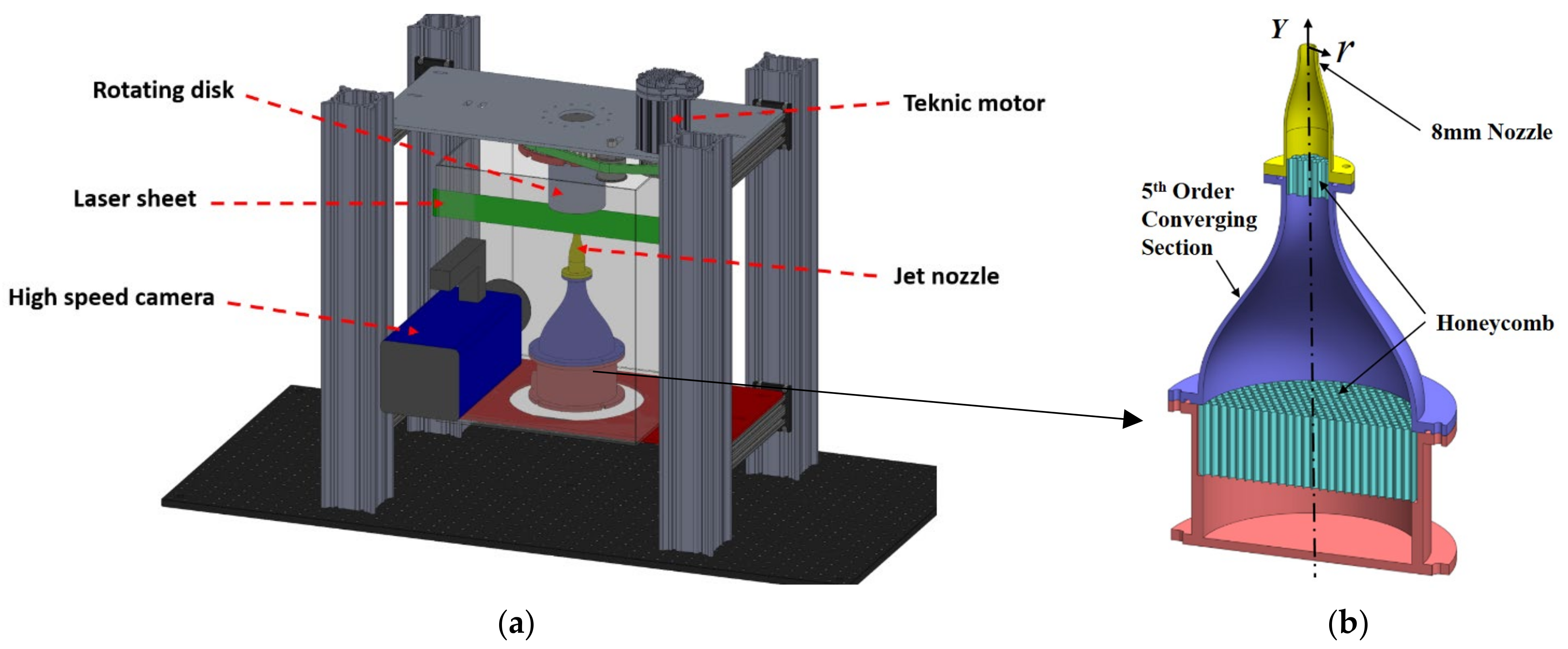
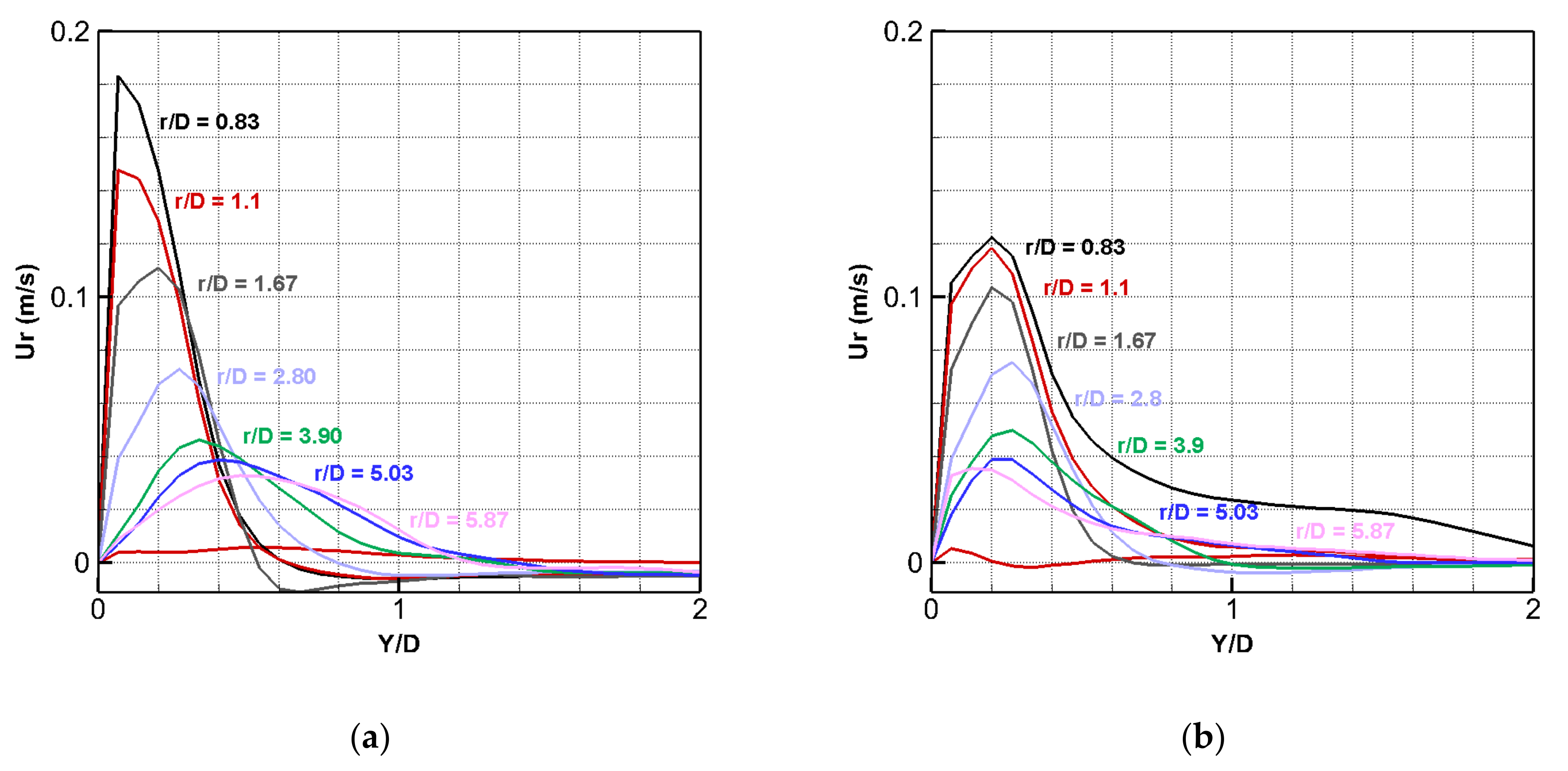



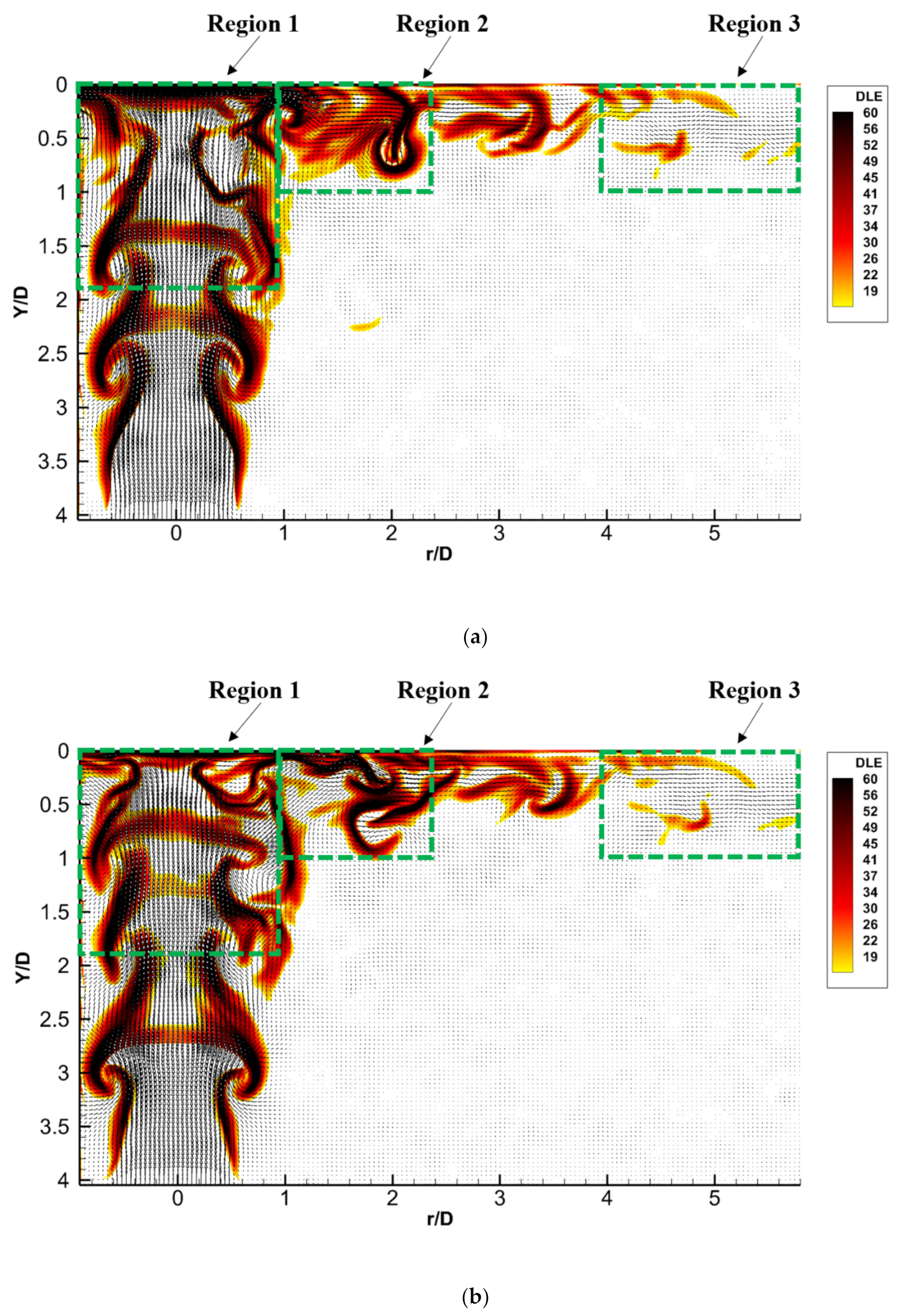
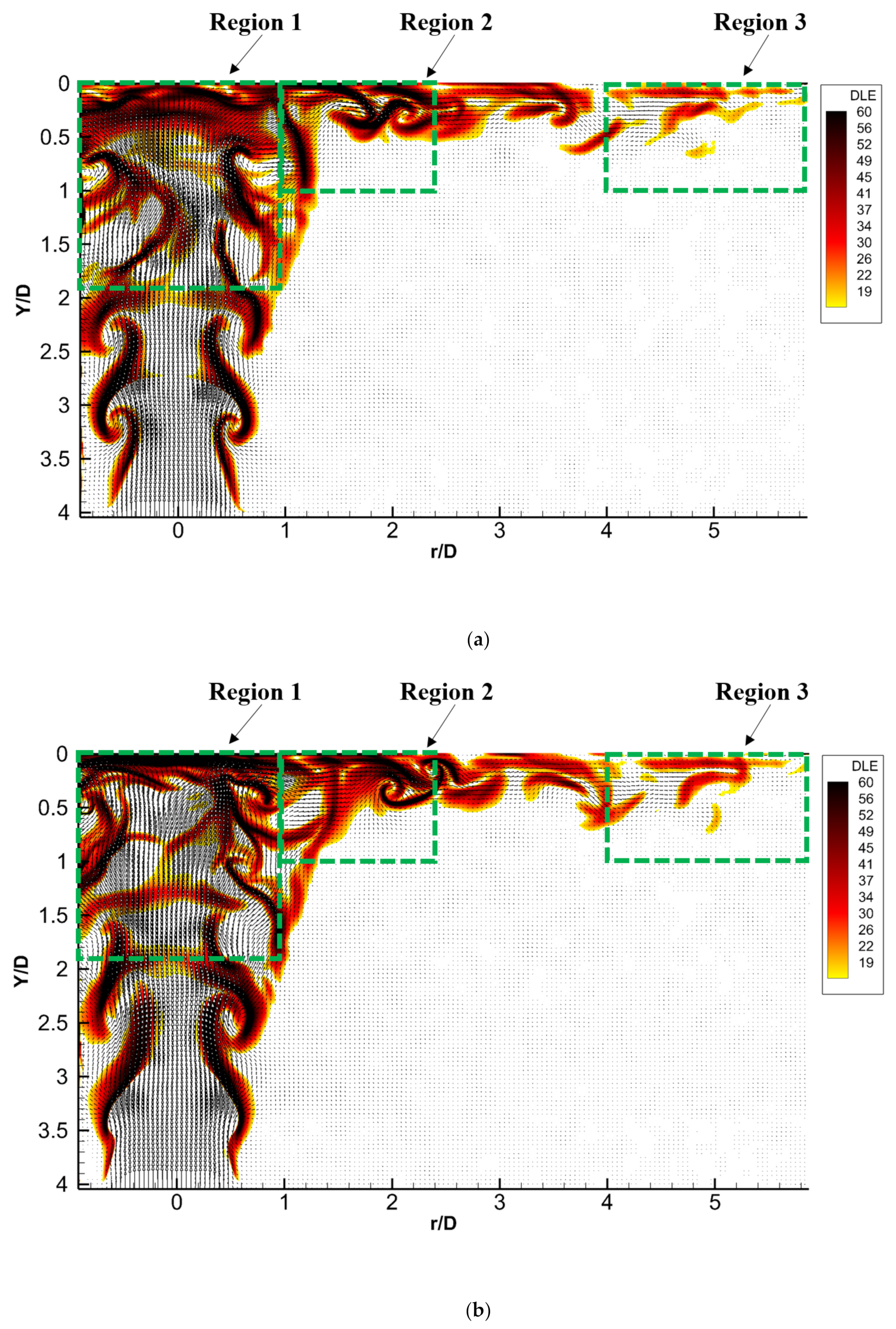
Publisher’s Note: MDPI stays neutral with regard to jurisdictional claims in published maps and institutional affiliations. |
© 2022 by the authors. Licensee MDPI, Basel, Switzerland. This article is an open access article distributed under the terms and conditions of the Creative Commons Attribution (CC BY) license (https://creativecommons.org/licenses/by/4.0/).
Share and Cite
El Hassan, M.; Nobes, D.S. Experimental Investigation of the Vortex Dynamics in Circular Jet Impinging on Rotating Disk. Fluids 2022, 7, 223. https://doi.org/10.3390/fluids7070223
El Hassan M, Nobes DS. Experimental Investigation of the Vortex Dynamics in Circular Jet Impinging on Rotating Disk. Fluids. 2022; 7(7):223. https://doi.org/10.3390/fluids7070223
Chicago/Turabian StyleEl Hassan, Mouhammad, and David S. Nobes. 2022. "Experimental Investigation of the Vortex Dynamics in Circular Jet Impinging on Rotating Disk" Fluids 7, no. 7: 223. https://doi.org/10.3390/fluids7070223






